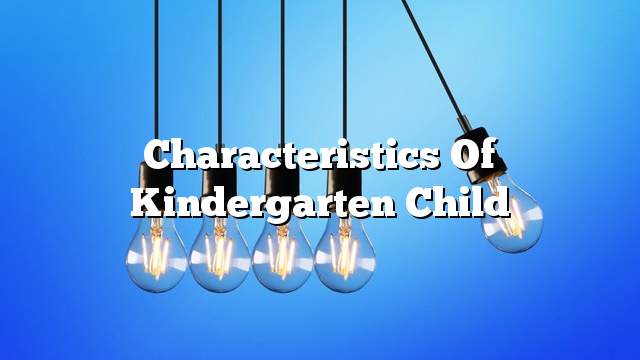Characteristics of Kindergarten Child
During the course of his life, man passes through many different stages. Each of these stages has its own characteristics that distinguish it from the other stages, including the Kindergarten which includes children from the age of three years to the age of five. The child at this stage has many characteristics at all levels, Personal, or mental, and in this article we will learn about the characteristics of the kindergarten child.
Physical characteristics
The physical characteristics of the child differ in kindergarten, from the rest of the stages. These characteristics include the following:
- The ability to control the body, and enjoy the activities carried out, it is often the activity of the child at this stage is outstanding, so the child must be engaged in sports such as running and jumping; to employ this excess movement in something useful.
- So that the child needs at this stage to rest periods between each activity and another, or the separation between activities that consume their strengths with simple exercises, through which they can take the rest they need.
- The growth of the leg muscles is faster than the growth of the fine muscles that cover his fingers and hands, so the child is unable to tie his shoes or close the buttons of his shirt, so the kindergarten teacher should avoid activities that rely on the delicate baby muscles, paper leaves, .
- The child’s inability to focus on small things, so it is difficult to coordinate between what he sees, and what he does with his hands, such as difficulty reading the word, causing them headaches sometimes.
- The child’s growth speed, so the child needs at this stage to provide large areas to perform activities, and this helps to grow the muscles and micro-accuracy together.
- Different growth speed between girls and boys. Females are faster than males at all levels and areas of growth, especially in skills that require precise movement.
- Using the right hand to perform activities, focusing more than the left hand, due to the comfort that the child feels when using his right hand.
Social characteristics
In the romancing stage, the child enjoys several social characteristics, including:
- The child’s relationship with his surroundings varies from kindergarten to kindergarten. At the age of three, his social relations are very limited, his friendships are few, and at the age of four he starts his real friendships, getting used to playing, cooperating and sharing colleagues.
- The high aggressive responses of the child in kindergarten, as a result of the frustration he is subjected to, in addition to the increased quarrels between children and the result of frequent friction and comparisons in the kindergarten, but it quickly ends.
- The practice of all desired, friendly and undesirable responses, such as aggressive differences, during the passage of the joy of social normalization, but the child quickly becomes more aware of his actions at the age of five, so his actions are proportional to his sex.
- Enjoy playing the stories they watch, and imitate the characters they love.
Emotional characteristics
The child is accompanied by some emotional characteristics, including:
- Expressing anger, joy and opinions, however freely and openly.
- The effects of the child affect the emotional environment, the child’s emotions increase as the number of adult family members, and is affected by time, as it increases in the afternoon and evening from the rest of the same day, due to the fatigue and hunger felt by the child in this times.
- The level of fear in children varies at this stage. The fear responses of females are greater than that of males.
Cognitive Characteristics
Kindergarten child has several cognitive characteristics including:
- High degree in the use of language, the method of vocabulary employment, the reason for this is due to the child’s love to speak before others, express himself.
- The high level of analysis and imagination in the kindergarten child, the characters he likes to fall on any tool he sees, such as imagine that the stick is a horse riding and running, and through the imagination connects the present and the past, and therefore shows signs of creativity and innovation on the child at this stage, This ability to visualize and analyze.
Tips for teacher and parents
There are several tips that teachers and parents should consider when dealing with kindergarten children:
- Increased interaction with the child in various ways and means.
- Pay attention to what the child does, say, interact with and promote.
- Giving the child room to search and discover, and motivate it.
- Encourage and reward the child for good and mature behaviors.
- Admiration for what he does, and his appreciation for what he does good works.
- Show love and respect to him in a loving and sincere way.
